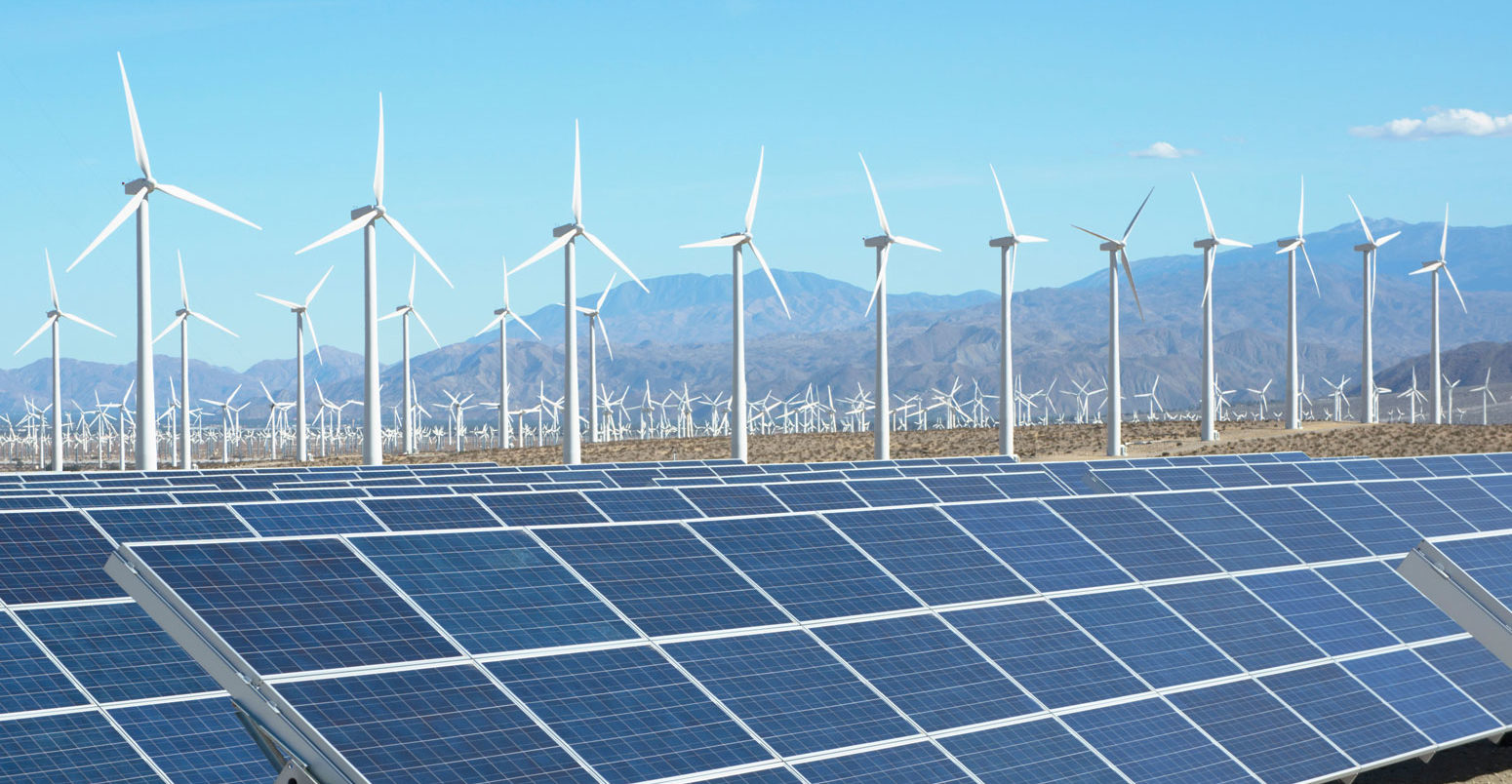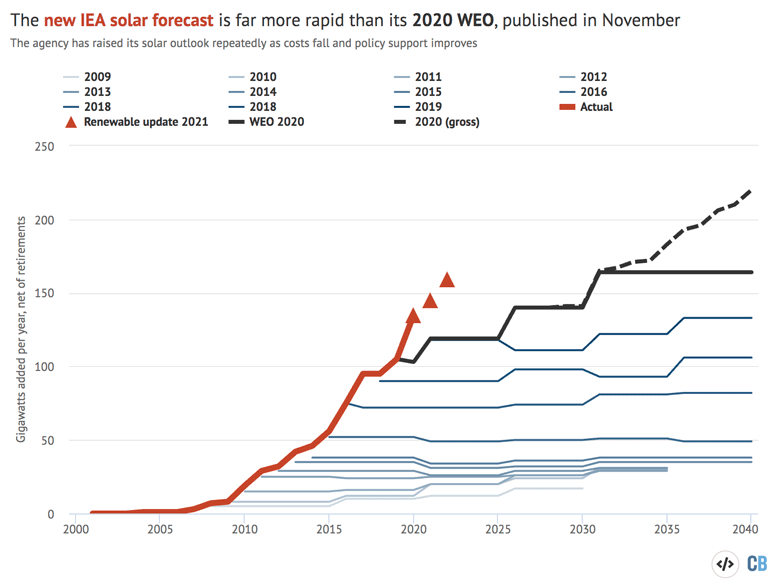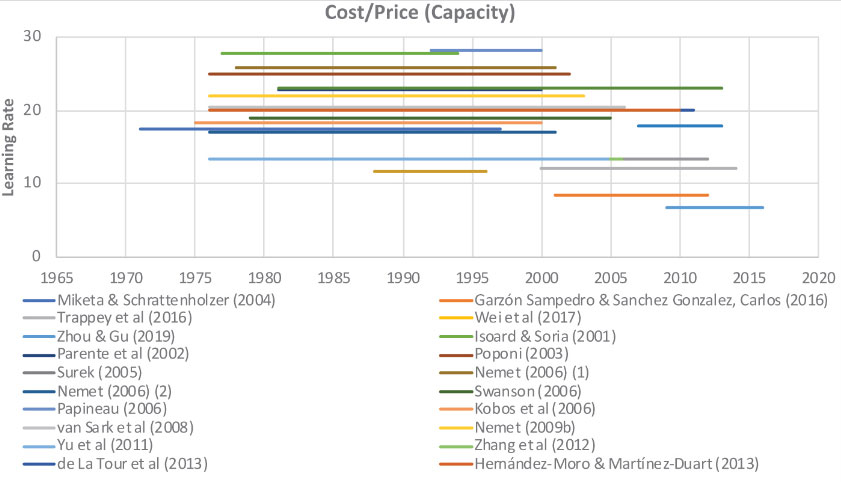
Guest post: Why the low carbon transition may be much cheaper than models predict

Guest authors
05.12.21
Guest authors
12.05.2021 | 4:34pmTo achieve net-zero emissions by mid-century, global energy systems must undergo a wholesale switch to low-carbon and energy-efficient technologies.
However, many models used to chart this transition imply that there are benefits in delaying investment in these technologies, waiting instead for R&D to drive down costs over time.
Such models overlook findings from a vast literature showing that the costs of these technologies decline as a result of their use.
Our new paper in Environmental Research Letters draws on evidence from more than 200 journal articles and concludes that policies promoting such “induced innovation” have been a clear factor behind the remarkable success of low-carbon technologies.
This suggests that not only is urgent action essential to facilitate the clean energy transition, but the transition itself may also end up much cheaper than predicted.
Models vs. reality
Government decarbonisation strategies often draw heavily on the outputs of integrated assessment models (IAMs) that attempt to represent the energy system and economy.
These models select combinations of energy-supply and energy-using technologies to achieve decarbonisation with the lowest total cost over time.
Nobel laureate William Nordhaus’ dynamic integrated climate-economy (DICE) model has been particularly influential in the economics community.
Typically, the costs of low-carbon technologies in these models are assumed to gradually decline as they become more mature, primarily as a function of time, but also through policies such as R&D support.
This means that even though the costs of mature, incumbent technologies are usually assumed to stay largely stable, low-carbon technologies remain more expensive long into the future.
As such, switching to low-carbon technologies to achieve decarbonisation generally comes at a considerable cost.
While technology cost assumptions may be adequate for mature technologies with well-known characteristics, they can be wide of the mark for immature technologies.
This is evident for solar power, which has already reached costs well below 2050 forecasts from just a few years ago.
In a remarkable turnaround, the International Energy Agency (IEA) says solar now offers the “cheapest electricity in history”, leading to a “new normal” with exceptional levels of ongoing deployment, well above its previous forecasts. This can be seen in the Carbon Brief chart below.

Models that do not account for the dynamics that lead to such developments are likely to vastly underutilise key technologies and overestimate costs.
Typically, the importance of “technology-push” policies, such as R&D funding, is well represented in models – or at least assumed through projected cost reductions. But the role played by “demand-pull” policies – those that create, expand or improve the market for new technologies – tend to be overlooked.
A growing literature argues that accounting for such policies in economic models may produce results that imply earlier, larger-scale investment in low-carbon energy at a lower long-run cost.
Efforts to address this problem have been challenged by the disparate, poorly characterised and often disputed evidence surrounding demand-pull induced innovation.
In our new paper, we attempt to fill this gap by synthesising 228 academic journal articles from across a broad range of research disciplines, sectors, technologies, timeframes and geographies.
We find unequivocally that since the 1970s oil price shocks, innovation in energy technologies has responded to energy prices, large scale deployment, and strategic low-carbon policies.
“Demand-pull” drivers
Demand-pull drivers of innovation can take various forms, from “market-wide” phenomena such as rising energy and carbon prices, or “targeted” policies such as technology subsidies or regulations.
Different drivers appear to induce innovation in different ways.
Rising energy and carbon prices do incentivise the development of lower-cost or lower-carbon technologies, but such innovation has so far been quite incremental.
It has been driven by incumbents making marginal improvements to retain a competitive advantage, such as automotive companies investing in more efficient fossil-fuelled vehicles, rather than electric or hydrogen technologies.
We find that more radical innovation – necessary to deliver newer, initially expensive renewable energy technologies – was much more responsive to targeted policy approaches.
Feed-in tariffs (FiTs) are by far the most widely adopted instrument targeting the deployment of renewable electricity. They provide a fixed subsidy per unit of generation, usually for 10-20 years.
The evidence suggests that the security provided by FiTs has given a strong incentive for innovation in low-carbon technologies, particularly for solar power.
Some studies offer insight into how policy instruments in combination influence innovation. Overall, we found that:
- Radical innovation in low carbon technologies is triggered by targeted policies that provide market confidence and overcome entry barriers.
- Firms are much more likely to innovate if they have done so before, such that encouraging innovation can have positive and reinforcing accumulation effects.
- The wider policy environment is important in determining innovation impacts, whereby factors such as overall policy coherence and consistency, future policy expectations and institutional context can have a strong influence on the propensity to innovate.
Measures of innovation
Patent applications are by far the most common measure of innovation, largely because data is widely available, quantifiable and detailed. However, they provide only a partial picture.
Patents are a good measure of innovative “activity”, but not of “outcomes” such as reductions in technology cost.
Examining the full link between demand-pull drivers and outcomes is highly complex and, as a result, relatively few studies do so directly.
In our review, we attempt to partially bridge this gap by including studies deriving “experience curves” and associated “learning rates” – the percentage reduction in cost for each doubling of cumulative deployment – for low-carbon technologies deployed as a result of demand-pull policies.
Solar and wind energy were by far the most studied technologies of those we considered, with the former experiencing a learning rate averaging around 20% for much of the last 40 years.
The solar learning rates from the literature we reviewed are shown in the figure below in terms of cost decrease per unit of installed capacity. The length of the coloured line indicates the period over which the average rate was calculated.

Much of this cost reduction is attributed to learning-by-doing and economies of scale that come when a new technology is deployed and the supply chains and markets around it develop.
Some studies that strip out the role of other influences, such as R&D funding and the price of energy and materials, typically find lower – but clearly positive – learning rates.
Declining technology costs also induce further deployment, which can muddy the waters when examining the factors driving experience curves. Although few studies attempt to explicitly test the direction of causality, those that do find a strong role for deployment-induced learning and economies of scale.
The evidence clearly shows that expanding deployment is positively correlated with cost reductions, across a wide range of technologies.
Modelling myths
If we better account for the role of induced innovation, our energy-economic models may paint a very different picture of the best route to decarbonisation and how much it will cost.
A recent paper, Modelling Myths, led by Prof Michael Grubb – also the lead author of our new systematic review – explores the impact of including induced innovation, along with inertia and path-dependence, in Nordhaus’ DICE model, with striking results.
It finds that the “optimal” initial investment in low-carbon technologies increases several-fold, yet the whole-system costs for the overall transition are reduced.
This implies that early investment leads to a low carbon energy system that may be cheaper than the fossil-based system it replaces, which stands in stark contrast to the high cost of decarbonisation implied when such dynamics are not considered.
We recognise that incorporating innovation impacts into models introduces significant complexity which in many cases is undesirable and may not be appropriate to try.
However, it is crucial that policymakers and those advising them are aware of these complexities and recognise the opportunities that early, large-scale investment may offer.
Grubb, M. et al. (2021) Induced innovation in energy technologies and systems: a review of evidence and potential implications for CO2 mitigation, doi.org/10.1088/1748-9326/abde07
Grubb, M., Wieners, C. & Yang, P. (2021) Modeling myths: On DICE and dynamic realism in integrated assessment models of climate change mitigation, doi.org/10.1002/wcc.698
-
Guest post: Why the low carbon transition may be much cheaper than models predict

